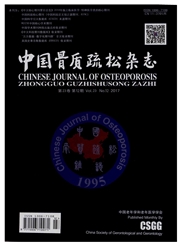

 中文摘要:
中文摘要:
目的研究脊髓损伤大鼠骨髓间充质干细胞(mesenchymal stem cells,MSCs)源性成骨细胞内NK1受体的分布。观察不同浓度、不同时间P物质(substance P,SP)对成骨细胞增殖的影响。用SP非特异性的阻滞剂和NKI受体特异性的阻滞剂进行干预,从而推测其作用细胞的靶受体,揭示其在脊髓损伤后骨质疏松发病中的作用机制。方法10只雄性6周龄SD大鼠制作脊髓损伤(spinal cord injuy,SCI)模型。取SC13周大鼠的双侧胫骨、股骨,用DMEM完全培养液冲洗髓腔后收集细胞悬液。首先进行骨髓MSCs源性成骨细胞的诱导培养,用第2代细胞进行实验。用免疫组织化学法检测MSCs源性成骨细胞内是否有NK1受体的表达。然后用SP、Spantide(SP的抑制剂)、L703606(NK1受体的抑制剂)进行配伍作用,并施加不同浓度的SP,对照组不加任何处理因素,在不同的时间点观察骨髓MSCs源性成骨细胞增殖的改变。结果脊髓损伤后大鼠骨髓MSCs源性成骨细胞膜及胞浆内存在NKl受体的分布,胞浆内含量较多。与对照组比较不同浓度的SP对细胞的增殖有不同程度的促进作用,10μmol/L浓度的促进作用最强(+124.5%,P〈0.01),且增殖具有时间依赖性,随时问延长增殖越旺盛(96h:+121.8%,P〈0.01)。细胞的增殖可以被Spantide和L703606所抑制,与SP组比较两者分别抑制了48.3%和45.4%。结论脊髓损伤后导致的骨质疏松,除了废用性因素以外,神经损伤所诱发的骨代谢异常有重要作用。本研究发现NK1受体存在于骨髓MSCs源性成骨细胞中,NK1受体是SP作用的靶受体,SP通过NK1受体对成骨细胞的增殖产生影响。
 英文摘要:
英文摘要:
Objective The main purpose of this study is to investigate the proliferation of osteoblasts after treated with SP in different density and different time course. Moreover, nonspecific and specific receptor blocking agents of SP were used to identify target receptors mediated SP action. This study is to research the effects of SP on biological behaviour of MSCs derived osteoblasts, and to reveal the pathogenesis of OP after SCI. Methods MSCs from tibiae and femurs in SCI rats were cultured under control mediums and induced to become osteoblasts. The expression of NK1 receptors in osteoblasts was observed using immunohistochemistry method. Cell proliferation was evaluated by MTT method. Every experiment was done with different conditions including various density, time, and blocking agents. Results The expression of NK1 receptors in bone marrow MSCs derived osteoblasts was observed on plasma membranes and in cytoplasm and the latter had high expression. Different concentrations of SP enhanced cell proliferation with time dependence compared with CON group (96 h: + 121.8% , P 〈0.01 ). The promotion of 10^-8 mol/L SP was the most powerful ( + 124. 5% , P 〈 0. 01 ). The increased cell proliferation induced by SP can be inhibited by spantide and L703606,the inhibitory effects were 48.3% and 45.4% respectivly compared with SP group. Conclusion SCI-induced abnormalities of bone metabolism play an important role in the osteoporosis after SCI. NK1 receptors were the target receptors of SP in osteoblasts. SP influenced cell proliferation through NK1 receptors.
 同期刊论文项目
同期刊论文项目
 同项目期刊论文
同项目期刊论文
 期刊信息
期刊信息
